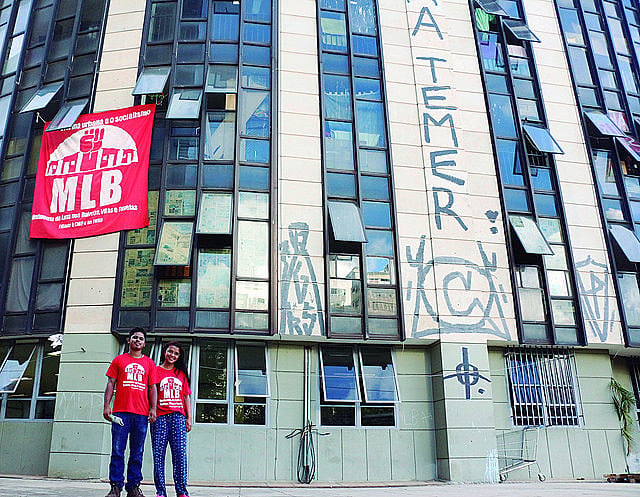“After what happened in São Paulo, the media suddenly ‘discovered’ that there are homeless people in the country. They just forgot that there are homeless people all year round,” says Edinho Vieira, from the Housing Movement in Neighborhoods, Villages, and Slums (Movimento de Luta dos Bairros, Vilas e Favelas – MLB), in Belo Horizonte, Southeast Brazil.
The case mentioned by the activist is a tragic fire that destroyed a squatted tower block in downtown São Paulo on May 1st that was extensively covered by the mainstream media. According to official city data, around 630 people – including adults and children – had been occupying the high-rise since 2003. The building collapsed because of the fire and the survivors, many who escaped with nothing but their lives, set out camp by a church nearby. They have been waiting ever since for answers and help from the authorities.
Back in his hometown Belo Horizonte, Vieira and other 200 families have been living in the central area of the city since September 2017, occupying the Carolina Maria de Jesus Building, named after the Brazilian slum resident and best-selling author from the mid-20th century.
He mentions numerous threats he and the community have to endure for living in a squatted building. Police helicopters are constantly flying over and public servants harass residents. But the greatest threat is inconspicuous: the fear of having nowhere to go in case of eviction. Most squatters moved to the occupied building in the first place because they were struggling – or simply not able to afford – to pay rent, or even as an alternative to leave the streets.
Now they have organized a system in which the previously-abandoned 15-story building is functional enough to house families with children and elders.
Márcia Ferreira dos Santos, a kitchen assistant who works in a neighboring area, lives with her husband, two children, and a grandchild in an apartment they fixed in the squatted building. Her husband, who works as a street cleaner, made furniture for their new home, while she nicely decorated the place where all her family can sleep, making sure to keep it tidy.
“After 14 years waiting for Minha Casa Minha Vida [one of Brazil’s major federal affordable housing programs], this was my alternative to have a home,” she adds. “It [the program] used to be focused on low-income people, but now it looks like it’s for people who are well off,” Santos adds. Despite concerns and fears of unemployment and eviction, she says that her life has improved since she moved to the occupation.
Child care and kitchen
Residents take turns working in a child care space set up to watch over approximately 70 children who live in the building, an opportunity that makes Santos feel relieved now that she has someone to leave her children with to go to work.
For safety reasons, stoves are not allowed inside the apartments, so the community has also set up a collective kitchen where four daily meals are cooked every day for the families.
“Now we have a community kitchen that is available to all residents. We have schedules, we take turns, there’s a child care center. With the child care space here, children have fun and we help the mothers, who have a place for their children to stay [while their working],” says Karina Estefânia, one of the coordinators of the squatted building and also a member of the MLB.
They also organize a thrift store, a community garden, events, and an internal security system. The clothes donated to them are handed to the families and help the collective financially. During events, they usually collect food, which is also shared among everyone. Under the pilotis, which were taken over by vegetation before they occupied the building, the community now grows vegetables and herbs.
“We are growing okra, we’re going to grow arugula, chicory, sow thistle, and down there, kale and lettuce,” Edima Siqueira dos Santos Cristo proudly lists. She is a supporter of the community who helps take care of the garden and says her mother, who was a midwife, taught her to appreciate helping others.
Emily da Silva Costa, a 10-year-old girl who lives in another neighborhood, often visits the community with her mother, not only to help, but also to play with her newfound friends in the Carolina community. Other kids who live nearby also come together and talk about how cool it is to make new friends and get to “play and draw” with buddies who live so close to them.
While the atmosphere is peaceful, they also point out they are afraid to leave the squatted building and have nowhere to go. “I hope we can stop the eviction and get our homes. If my mother doesn’t get it, we will have to live under a bridge, because my mom doesn’t have a home,” Adriele Christina Oliveira Rodrigues says.
Eviction
The Carolina Maria de Jesus Building – named after the author of “Child of the Dark,” a diary about life in a slum in São Paulo – was not among the squatted areas recognized by the local and state governments in April after pressures from housing movements for land regularization and public services.
The building used to house the health department and is owned by a social security foundation. The company’s lawyer says there is a writ of eviction that has not been enforced yet, but since the fire in São Paulo, the pressure against residents of other squatted areas has increased all over Brazil.
“We just want these families to have a decent home. You can’t have them evicted and living in a warehouse or under a marquee. We want a decent alternative,” Edinho Vieira points out.
According to the João Pinheiro Foundation, an agency that offers technical support to the Minas Gerais state government, Belo Horizonte faces a housing shortage of 78,000 units. However, the official data are from 2010 and may be outdated.




